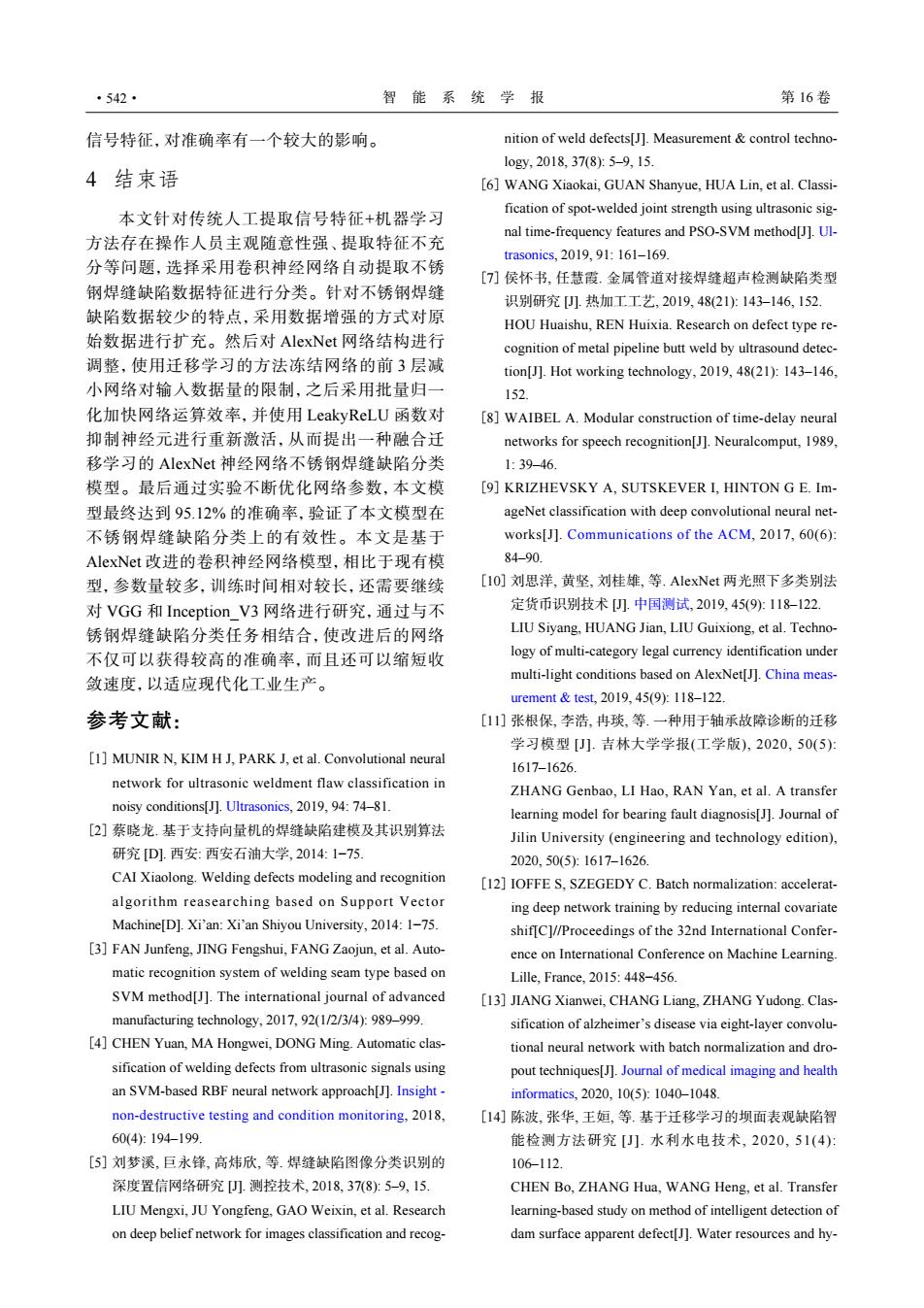正在加载图片...

·542· 智能系统学报 第16卷 信号特征,对准确率有一个较大的影响。 nition of weld defects[J].Measurement control techno- 10gy,2018,37(8):5-9,15. 4结束语 [6]WANG Xiaokai,GUAN Shanyue,HUA Lin,et al.Classi- fication of spot-welded joint strength using ultrasonic sig- 本文针对传统人工提取信号特征+机器学习 nal time-frequency features and PSO-SVM method[J].Ul- 方法存在操作人员主观随意性强、提取特征不充 trasonics,2019,91:161-169 分等问题,选择采用卷积神经网络自动提取不锈 [7]侯怀书,任慧霞.金属管道对接焊缝超声检测缺陷类型 钢焊缝缺陷数据特征进行分类。针对不锈钢焊缝 识别研究.热加工工艺,2019,48(21):143-146,152 缺陷数据较少的特点,采用数据增强的方式对原 HOU Huaishu,REN Huixia.Research on defect type re- 始数据进行扩充。然后对AlexNet网络结构进行 cognition of metal pipeline butt weld by ultrasound detec- 调整,使用迁移学习的方法冻结网络的前3层减 tion[J].Hot working technology,2019,48(21):143-146, 小网络对输入数据量的限制,之后采用批量归一 152 化加快网络运算效率,并使用LeakyReLU函数对 [8]WAIBEL A.Modular construction of time-delay neural 抑制神经元进行重新激活,从而提出一种融合迁 networks for speech recognition[J].Neuralcomput,1989. 移学习的AlexNet神经网络不锈钢焊缝缺陷分类 1:39-46. 模型。最后通过实验不断优化网络参数,本文模 [9]KRIZHEVSKY A,SUTSKEVER I,HINTON G E.Im- 型最终达到95.12%的准确率,验证了本文模型在 ageNet classification with deep convolutional neural net- 不锈钢焊缝缺陷分类上的有效性。本文是基于 works[J].Communications of the ACM,2017,60(6): AlexNet改进的卷积神经网络模型,相比于现有模 84-90. 型,参数量较多,训练时间相对较长,还需要继续 [IO]刘思洋,黄坚,刘桂雄,等.AlexNet两光照下多类别法 对VGG和Inception V3网络进行研究,通过与不 定货币识别技术[.中国测试,2019,45(9):118-122. 锈钢焊缝缺陷分类任务相结合,使改进后的网络 LIU Siyang,HUANG Jian,LIU Guixiong,et al.Techno- 不仅可以获得较高的准确率,而且还可以缩短收 logy of multi-category legal currency identification under 敛速度,以适应现代化工业生产。 multi-light conditions based on AlexNet[J].China meas- urement&test,2019,45(9)118-122. 参考文献: [11]张根保,李浩,冉琰,等.一种用于轴承故障诊断的迁移 学习模型[J].吉林大学学报(工学版),2020,50(5): [1]MUNIR N.KIM H J,PARK J,et al.Convolutional neural 1617-1626 network for ultrasonic weldment flaw classification in ZHANG Genbao,LI Hao,RAN Yan,et al.A transfer noisy conditions[J.Ultrasonics,2019,94:74-81. learning model for bearing fault diagnosis[J].Journal of [2]蔡晓龙.基于支持向量机的焊缝缺陷建模及其识别算法 Jilin University(engineering and technology edition), 研究D].西安:西安石油大学,2014:1-75 2020,50(5:1617-1626. CAI Xiaolong.Welding defects modeling and recognition [12]IOFFE S,SZEGEDY C.Batch normalization:accelerat- algorithm reasearching based on Support Vector ing deep network training by reducing internal covariate Machine[D].Xi'an:Xi'an Shiyou University,2014:1-75. shif[C]//Proceedings of the 32nd International Confer- [3]FAN Junfeng,JING Fengshui,FANG Zaojun,et al.Auto- ence on International Conference on Machine Learning. matic recognition system of welding seam type based on Lile,France,.2015:448-456. SVM method[J].The international journal of advanced [13]JIANG Xianwei,CHANG Liang,ZHANG Yudong.Clas- manufacturing technology,2017,92(1/2/3/4):989-999. sification of alzheimer's disease via eight-layer convolu- [4]CHEN Yuan,MA Hongwei,DONG Ming.Automatic clas- tional neural network with batch normalization and dro- sification of welding defects from ultrasonic signals using pout techniques[J].Journal of medical imaging and health an SVM-based RBF neural network approach[J].Insight- informatics,2020,10(5):1040-1048 non-destructive testing and condition monitoring,2018, [14]陈波,张华,王姮,等.基于迁移学习的坝面表观缺陷智 60(4):194199. 能检测方法研究[].水利水电技术,2020,51(4) [5]刘梦溪,巨永锋,高炜欣,等.焊缝缺陷图像分类识别的 106-112 深度置信网络研究).测控技术,2018,37(8):5-9,15. CHEN Bo,ZHANG Hua,WANG Heng,et al.Transfer LIU Mengxi,JU Yongfeng,GAO Weixin,et al.Research learning-based study on method of intelligent detection of on deep belief network for images classification and recog- dam surface apparent defect[J].Water resources and hy-信号特征,对准确率有一个较大的影响。 4 结束语 本文针对传统人工提取信号特征+机器学习 方法存在操作人员主观随意性强、提取特征不充 分等问题,选择采用卷积神经网络自动提取不锈 钢焊缝缺陷数据特征进行分类。针对不锈钢焊缝 缺陷数据较少的特点,采用数据增强的方式对原 始数据进行扩充。然后对 AlexNet 网络结构进行 调整,使用迁移学习的方法冻结网络的前 3 层减 小网络对输入数据量的限制,之后采用批量归一 化加快网络运算效率,并使用 LeakyReLU 函数对 抑制神经元进行重新激活,从而提出一种融合迁 移学习的 AlexNet 神经网络不锈钢焊缝缺陷分类 模型。最后通过实验不断优化网络参数,本文模 型最终达到 95.12% 的准确率,验证了本文模型在 不锈钢焊缝缺陷分类上的有效性。本文是基于 AlexNet 改进的卷积神经网络模型,相比于现有模 型,参数量较多,训练时间相对较长,还需要继续 对 VGG 和 Inception_V3 网络进行研究,通过与不 锈钢焊缝缺陷分类任务相结合,使改进后的网络 不仅可以获得较高的准确率,而且还可以缩短收 敛速度,以适应现代化工业生产。 参考文献: MUNIR N, KIM H J, PARK J, et al. Convolutional neural network for ultrasonic weldment flaw classification in noisy conditions[J]. Ultrasonics, 2019, 94: 74–81. [1] 蔡晓龙. 基于支持向量机的焊缝缺陷建模及其识别算法 研究 [D]. 西安: 西安石油大学, 2014: 1−75. CAI Xiaolong. Welding defects modeling and recognition algorithm reasearching based on Support Vector Machine[D]. Xi’an: Xi’an Shiyou University, 2014: 1−75. [2] FAN Junfeng, JING Fengshui, FANG Zaojun, et al. Automatic recognition system of welding seam type based on SVM method[J]. The international journal of advanced manufacturing technology, 2017, 92(1/2/3/4): 989–999. [3] CHEN Yuan, MA Hongwei, DONG Ming. Automatic classification of welding defects from ultrasonic signals using an SVM-based RBF neural network approach[J]. Insight - non-destructive testing and condition monitoring, 2018, 60(4): 194–199. [4] 刘梦溪, 巨永锋, 高炜欣, 等. 焊缝缺陷图像分类识别的 深度置信网络研究 [J]. 测控技术, 2018, 37(8): 5–9, 15. LIU Mengxi, JU Yongfeng, GAO Weixin, et al. Research on deep belief network for images classification and recog- [5] nition of weld defects[J]. Measurement & control technology, 2018, 37(8): 5–9, 15. WANG Xiaokai, GUAN Shanyue, HUA Lin, et al. Classification of spot-welded joint strength using ultrasonic signal time-frequency features and PSO-SVM method[J]. Ultrasonics, 2019, 91: 161–169. [6] 侯怀书, 任慧霞. 金属管道对接焊缝超声检测缺陷类型 识别研究 [J]. 热加工工艺, 2019, 48(21): 143–146, 152. HOU Huaishu, REN Huixia. Research on defect type recognition of metal pipeline butt weld by ultrasound detection[J]. Hot working technology, 2019, 48(21): 143–146, 152. [7] WAIBEL A. Modular construction of time-delay neural networks for speech recognition[J]. Neuralcomput, 1989, 1: 39–46. [8] KRIZHEVSKY A, SUTSKEVER I, HINTON G E. ImageNet classification with deep convolutional neural networks[J]. Communications of the ACM, 2017, 60(6): 84–90. [9] 刘思洋, 黄坚, 刘桂雄, 等. AlexNet 两光照下多类别法 定货币识别技术 [J]. 中国测试, 2019, 45(9): 118–122. LIU Siyang, HUANG Jian, LIU Guixiong, et al. Technology of multi-category legal currency identification under multi-light conditions based on AlexNet[J]. China measurement & test, 2019, 45(9): 118–122. [10] 张根保, 李浩, 冉琰, 等. 一种用于轴承故障诊断的迁移 学习模型 [J]. 吉林大学学报(工学版), 2020, 50(5): 1617–1626. ZHANG Genbao, LI Hao, RAN Yan, et al. A transfer learning model for bearing fault diagnosis[J]. Journal of Jilin University (engineering and technology edition), 2020, 50(5): 1617–1626. [11] IOFFE S, SZEGEDY C. Batch normalization: accelerating deep network training by reducing internal covariate shif[C]//Proceedings of the 32nd International Conference on International Conference on Machine Learning. Lille, France, 2015: 448−456. [12] JIANG Xianwei, CHANG Liang, ZHANG Yudong. Classification of alzheimer’s disease via eight-layer convolutional neural network with batch normalization and dropout techniques[J]. Journal of medical imaging and health informatics, 2020, 10(5): 1040–1048. [13] 陈波, 张华, 王姮, 等. 基于迁移学习的坝面表观缺陷智 能检测方法研究 [J]. 水利水电技术, 2020, 51(4): 106–112. CHEN Bo, ZHANG Hua, WANG Heng, et al. Transfer learning-based study on method of intelligent detection of dam surface apparent defect[J]. Water resources and hy- [14] ·542· 智 能 系 统 学 报 第 16 卷